Algonquin College is a Canadian college, which develops its business plan on an annual basis. The business plan for 2016 aimed at increasing the colleges graduation and first term retention rates by 1.5%. The financial plan for Algonquin College takes into consideration of the current funding model and the costs incurred throughout the fiscal period. The accumulated assets of Algonquin College have been improving every year since 2013-14 fiscal year. The annual net contribution for the 2013-14 period was $7.1 million. This was surplus with a variance of 21% of the total budgeted expenditures. The positive variance is an indication of the good financial performance of the college. The college is consistently achieving surpluses. The surpluses have helped the college to run its operations through engagement in a series of projects. The budgeted 2015-16 year-end total balances of unrestricted net assets were $1,000,000.
Balance Sheet (Statement of financial position)
The total net assets for the financial year 2015/2016 were $109, 749 an improvement from 2015 financial year which was $92,724. The total assets as at March 31, 2015, were $371,389. The current liabilities for were $45,109. The current liabilities are the money borrowed by the college that is used in assisting in running the daily operations of the college. The current assets are more than the current liabilities an indication that the college is running smoothly and it can sustain its current borrowings. The long-term debt for the college is attributed to deferred capital contributions and post-employment benefits.
Income Statement
The college relies on grants and contributions to run its operations. The total grants for the year were 107,418. The value for total grants is within the budgeted amount for the year. The total tuition fees collected from the students assist in helping in the running of the organization. The total tuition fees used in funding the total college operations of the organization were $83,936. The college total revenue is collected from different avenues. The avenues used by the college to collect its revenue are college operations, contract activity, college ancillary operations, international education Centre and strategic investments. The highest source of revenue for the organization is college operations. The total income from funds was $222,264.
Financial Ratios
The financial ratios are used in analyzing the financial performance of the organization. The operating results for the college for the period starting 2011 to 2016 have been dropping. It is however predicted that the annual surplus for the fiscal year 2017/2018 will increase. The surplus is used to measure the excess of revenues over expenses in a given year. The college has been witnessing a surplus for the past five years. The surplus for 2016 is projected to be below $0, which is an indication of a decline in the institutions financial health.
Liquidity (Quick Ratio)
The colleges objective for its liquidity position is to be used in indicating the colleges ability to pay its short-term maturing obligations. Examples of short-term obligations are the biweekly payroll payments. The ratio of 1 or higher is an indicator that the college can meet its short-term obligations. The quick ratio dropped below 1 for the fiscal year 2011/2012 but maintained higher ratio for the next financial periods. Algonquins quick ratio for 2014/15 is 2:1 an indicator that currently the college is in a position to meet its short-term obligations. The net assets to expense ratio is an indicator of colleges ability to continue operation in the event there is a delay in revenue streams. The net balance for the last five years has been more that 60% of the annual expenses an indication of lower tolerance for volatile revenues. The net income to revenue ratio is used to measure the returns an organization generates on each dollar of revenue. The surplus for 2014 is less than 1.5% of revenues an indicator that small changes in expenses or revenues would result in annual deficits for the college. The debt ratio for the past five years for the organization has been less 35%, which indicate that the firm is not vulnerable to creditors. Debt servicing ratio measures the college is spending on servicing the debt portfolio. The ratio is higher than 3% for the past five years an indication that the college is not spending much.
Conclusion
The financial statements of the Algonquin indicate that the college is financially healthy. The debt ratio shows that the college is not dependent on creditors in running of its daily operations. The college, therefore, can operate without having to stretch to look for external finances.
Cite this page
Overview of Algonquin College - Paper Example. (2021, Jun 17). Retrieved from https://midtermguru.com/essays/overview-of-algonquin-college-paper-example
If you are the original author of this essay and no longer wish to have it published on the midtermguru.com website, please click below to request its removal:
- The U-Shaped Acquisition
- Annotated Bibliography on Juvenile Delinquency and the Relation to Parenting Styles
- College Students and Underage Drinking - Essay Sample
- Essay Sample on Learning Bilingusim and Multilingusim
- How Do I View the Purpose of College? Essay Example
- Research Paper on Abortion and Planned Parenthood
- Early Literacy Skills: Essential for Kids' Growth and Adult Empowerment







